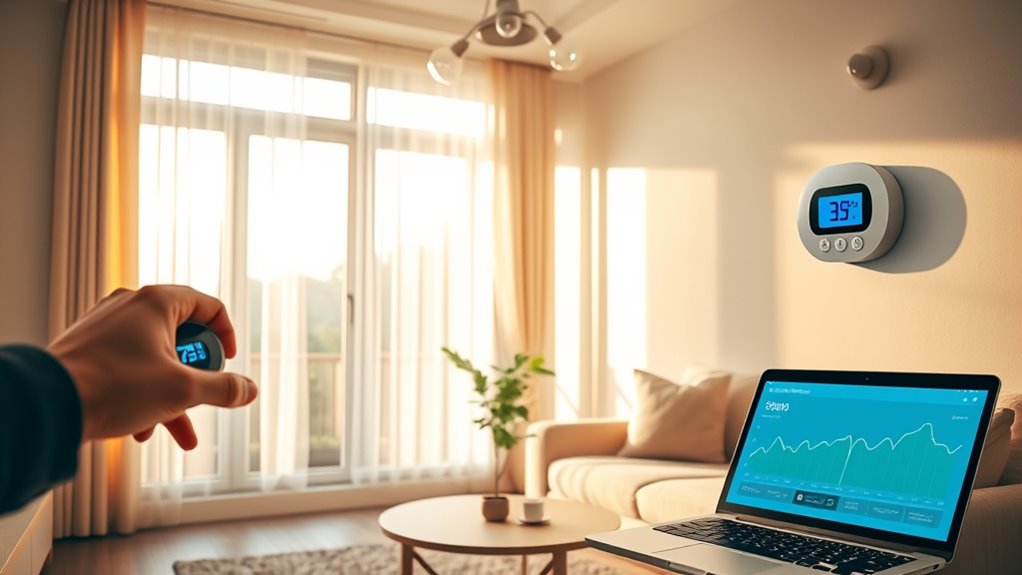To save energy at home, upgrade to ENERGY STAR appliances and keep them well-maintained to cut costs. Maximize natural light and airflow with smart window treatments and ventilation. Use smart thermostats to better control heating and cooling, and seal gaps with insulation and weatherstripping. Don’t forget water-saving fixtures and fixing leaks. For more practical tips to cut your energy use further, explore the full list of strategies that follow.
Key Takeaways
- Upgrade to energy-efficient appliances with high ENERGY STAR ratings and maintain them properly.
- Maximize natural light and cross-ventilation with window treatments and unobstructed airflow.
- Use smart thermostats to precisely control heating and cooling based on occupancy and climate zones.
- Seal gaps, insulate walls, attics, and floors to reduce heat transfer and HVAC energy consumption.
- Install low-flow fixtures, fix leaks promptly, and set water heaters to 120°F to conserve water and energy.
Upgrade to Energy-Efficient Appliances
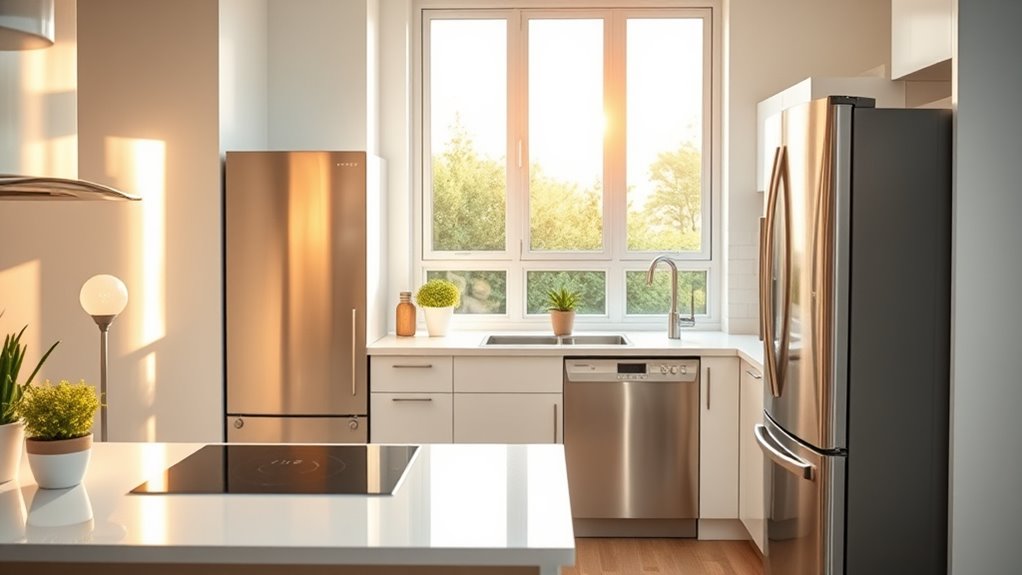
Upgrading to energy-efficient appliances is one of the most effective ways to reduce your home’s energy consumption. When selecting new appliances, prioritize models with high ENERGY STAR ratings, as they use less power and perform better. Proper appliance maintenance, like cleaning filters and checking for leaks, ensures your appliances operate at peak efficiency, saving you energy and money. Take the time to research different brands and features to find options that suit your needs and minimize energy waste. Replacing old, inefficient appliances with newer, energy-saving ones not only lowers your utility bills but also reduces your carbon footprint. Make informed appliance choices and keep them well-maintained to maximize your home’s energy efficiency.
Maximize Natural Light and Ventilation
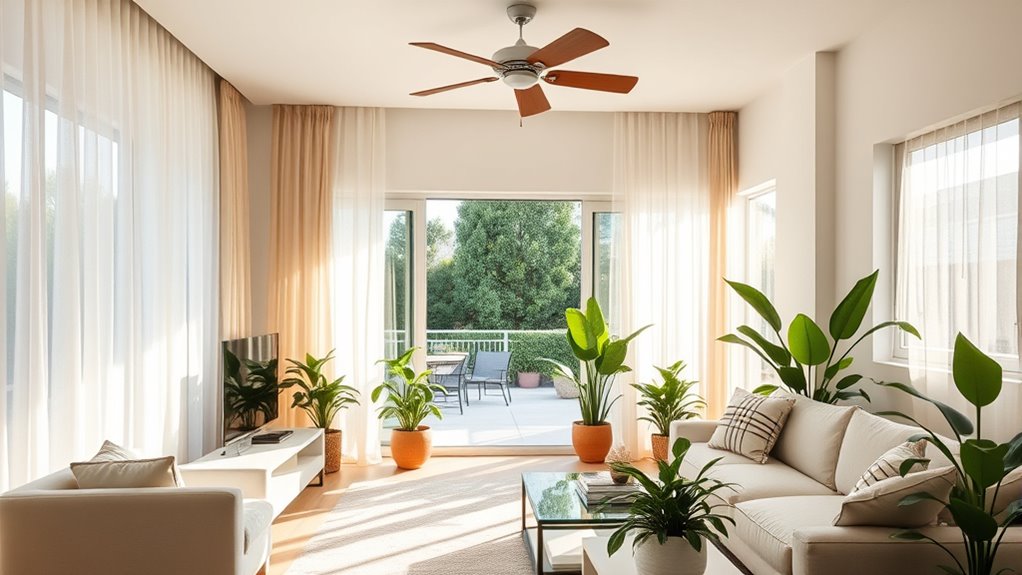
Maximizing natural light and ventilation can substantially reduce your home’s reliance on artificial lighting and mechanical cooling systems. To do this, choose window treatments that let in maximum sunlight during the day, like sheer curtains or blinds that can be easily adjusted. Keep windows unobstructed to improve airflow and encourage natural cross-ventilation. Incorporate indoor plants near windows; they not only brighten your space but also help filter air and promote better airflow. Open windows during cooler parts of the day to bring in fresh air and reduce indoor humidity. Strategically placing plants and selecting the right window treatments can make your home feel brighter, fresher, and more energy-efficient. Small adjustments like these can lead to significant energy savings over time.
Use Smart Thermostats for Better Climate Control
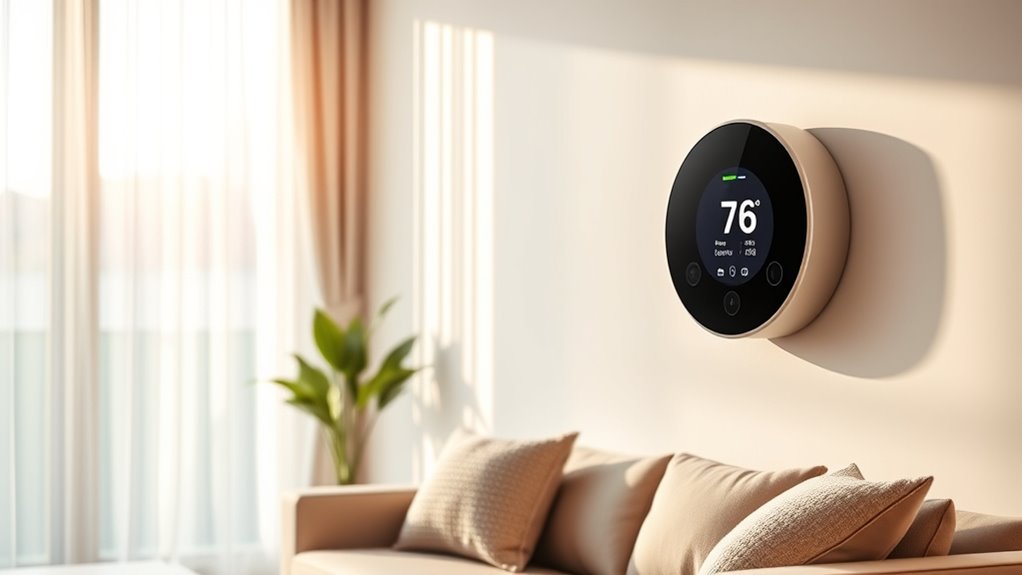
Smart thermostats can substantially improve your home’s energy efficiency by allowing you to control your heating and cooling systems more precisely. By adjusting smart thermostat settings based on your schedule and preferences, you prevent energy waste. Consider climate zone considerations to optimize performance—what works in one zone might not in another. Use the table below to understand key factors:
| Climate Zone | Ideal Thermostat Setting | Tips |
|---|---|---|
| Zone 1 | 68°F (20°C) in winter | Use scheduling features |
| Zone 2 | 75°F (24°C) in summer | Adjust for occupancy |
| Zone 3 | 65°F (18°C) in winter | Enable eco modes |
Implement Effective Insulation and Sealing
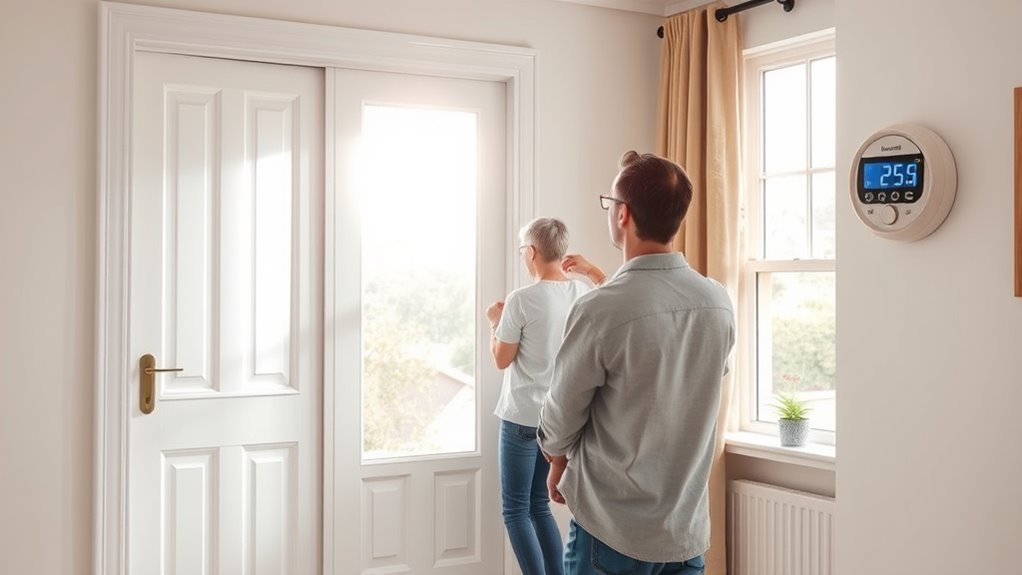
Effective insulation and sealing are key to maintaining a comfortable home and reducing energy waste. Proper thermal barriers prevent heat from escaping in winter and entering in summer, making your HVAC system more efficient. To improve your home’s energy performance, consider these steps:
- Seal gaps around windows and doors to prevent air infiltration.
- Insulate walls, attics, and floors with high-quality materials.
- Install weatherstripping and door sweeps to block drafts.
- Use caulk to seal cracks and gaps around pipes and outlets.
Adopt Water-Saving Fixtures and Practices
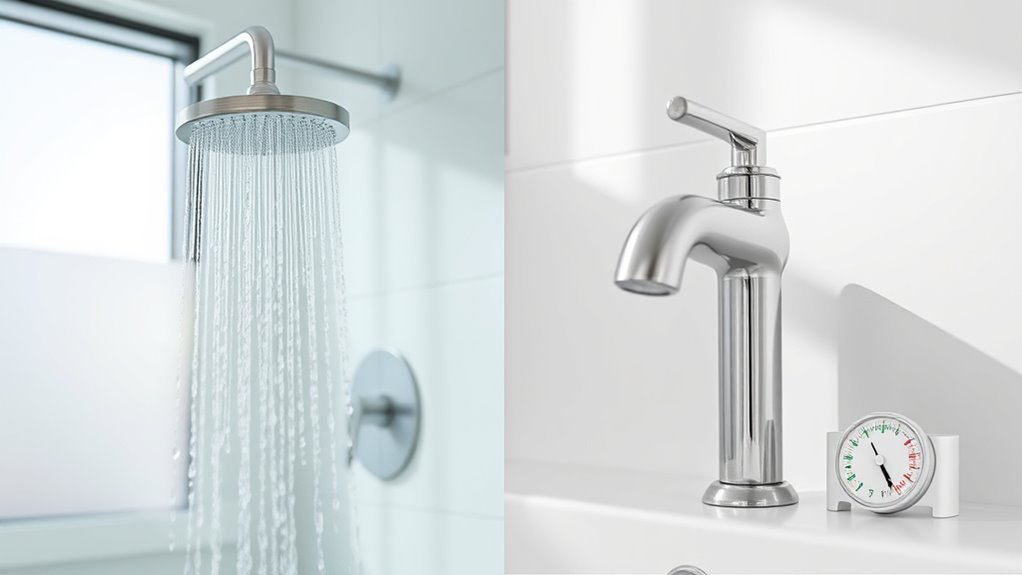
You can save water—and energy—by installing low-flow fixtures and practicing shorter showers. Fixing leaky faucets prevents waste and reduces your water bills. Small changes like these make a big difference for your home’s efficiency.
Install Low-Flow Fixtures
Have you considered how installing low-flow fixtures can substantially reduce your water usage? Upgrading your shower head and faucet aerator is a simple way to cut water waste without sacrificing performance. Here’s how you can maximize savings:
- Replace your existing shower head with a low-flow model to reduce flow rate.
- Install faucet aerators on sinks to limit water flow while maintaining pressure.
- Check all fixtures regularly for leaks and fix them promptly.
- Opt for dual-flush toilets to save water during flushing.
These small changes can significantly lower your water bill and conserve resources. Low-flow fixtures are easy to install and maintain, making them an effective step toward a more energy-efficient home.
Practice Shorter Showers
Building on the benefits of water-saving fixtures, practicing shorter showers is one of the simplest ways to cut water use daily. Reducing your shower duration not only conserves water but also lowers the energy needed to heat that water. Set your water heater to a moderate temperature—around 120°F (49°C)—to prevent unnecessary energy consumption. Shortening your shower time from 10 minutes to five can save gallons of water each day, considerably reducing your utility bills. Use a timer or turn off the shower while lathering to limit excess water flow. By being mindful of your shower duration and adjusting your water heater settings, you make a quick, impactful change that boosts your home’s energy efficiency and saves money.
Fix Leaking Faucets
Did you know that a leaking faucet can waste hundreds of gallons of water each year? Addressing leaks is simple with proper plumbing maintenance and leak detection. Here’s what you should do:
- Turn off the water supply before starting repairs.
- Inspect the faucet for worn-out washers or seals.
- Replace faulty parts with water-saving fixtures.
- Test the faucet to ensure no leaks persist.
Fixing leaks not only conserves water but also reduces your energy bills since less hot water is used. Regular plumbing maintenance helps catch leaks early, preventing waste and damage. By adopting water-saving fixtures and practicing leak detection, you contribute to energy efficiency at home. Keep your plumbing in top shape for ongoing savings and environmental benefits.
Maintain and Optimize Your Electrical Systems
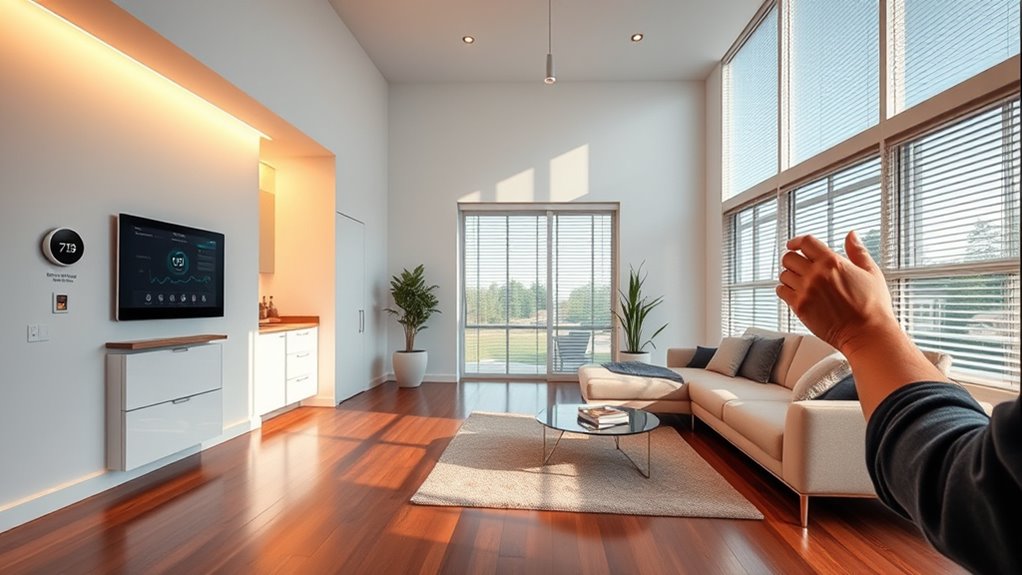
You should regularly inspect your electrical systems to spot potential issues early. Upgrading to energy-efficient devices can greatly reduce your home’s energy consumption. Taking these steps guarantees your systems run smoothly and save you money in the long run.
Regular System Inspections
How often do you think about the state of your electrical system? Regular system inspections are crucial for safe and efficient home maintenance. They help identify potential problems early, saving you money and preventing hazards. Here are four key steps:
- Schedule safety inspections annually to ensure all wiring and outlets are in good condition.
- Check for loose connections or signs of wear that could cause electrical failures.
- Test circuit breakers to confirm they trip correctly and protect your home.
- Look for overheating or discoloration around switches and outlets, indicating issues.
Upgrade to Energy-Efficient Devices
Have you considered how upgrading to energy-efficient devices can substantially reduce your home’s electricity consumption? Replacing old appliances with ENERGY STAR-rated ones saves energy and lowers bills. Installing solar panels can generate renewable power, decreasing reliance on the grid. Conducting an energy audit helps identify inefficient systems and appliances that waste energy. During the audit, you might find outdated lighting or heating units that can be upgraded. Smart thermostats and LED bulbs are simple, effective upgrades that improve efficiency. Upgrading devices not only cuts costs but also supports sustainability. Remember, regular maintenance of your electrical systems ensures everything runs at its best. Combining these steps with solar panel installation and energy audits maximizes your home’s energy savings and reduces your carbon footprint.
Frequently Asked Questions
How Much Can I Realistically Save Annually With Energy-Efficient Upgrades?
You can realistically save $200 to $600 annually with energy-efficient upgrades, depending on your home’s size and current energy use. A thorough cost analysis helps you understand the return on investment, while upgrade incentives from utilities or government programs can reduce initial costs. By prioritizing high-impact upgrades like insulation or efficient appliances, you maximize savings and make your home more eco-friendly.
Are There Specific Appliances That Offer the Best Energy Savings for Homes?
You’ll find that appliances with high energy star ratings offer the best energy savings for your home. When doing an appliance comparison, focus on refrigerators, dishwashers, and washing machines, as these often consume significant energy. Upgrading to Energy Star certified models can reduce your energy bills and environmental impact. Look for these ratings and compare features to make certain you’re choosing the most efficient appliances for your needs.
How Do I Determine the Optimal Settings for My Smart Thermostat?
To determine the ideal settings for your smart thermostat, start by analyzing your daily schedule and adjusting the temperature accordingly. Set higher temps when you’re away or asleep, and lower when you’re home and active during winter, and vice versa in summer. Use the thermostat’s learning feature, if available, and experiment gradually to find a balance between comfort and energy efficiency. Regularly monitor your energy usage for further fine-tuning.
What Are Common Mistakes to Avoid When Sealing and Insulating My Home?
When sealing and insulating your home, avoid overlooking air leaks around windows, doors, and electrical outlets. Don’t forget to check for insulation gaps in your attic, walls, and floors, as these reduce efficiency. Use weatherstripping and caulk to seal leaks, and add insulation where needed. Failing to address these issues leads to higher energy bills and uncomfortable drafts, so take your time to properly seal and insulate every vulnerable spot.
How Often Should I Inspect and Maintain Electrical Systems for Efficiency?
You should inspect and maintain your electrical systems at least once a year. Coincidentally, this is when you check for electrical safety issues and guarantee your system runs efficiently. Regular maintenance keeps your home safe, prevents costly repairs, and optimizes energy use. Stick to a maintenance schedule, and if you notice flickering lights or unusual sparks, address them immediately to avoid hazards and keep everything running smoothly.
Conclusion
Think of your home as a garden—you’re the gardener nurturing its health. By upgrading appliances, embracing natural light, and sealing leaks, you’re tending to a thriving, energy-efficient oasis. Smart thermostats and water-saving fixtures act like gentle rain and sunshine, helping your home flourish without wasting resources. With each mindful step, you cultivate a cozy, sustainable space that benefits both your wallet and the planet. Keep tending your energy garden, and watch it bloom!

